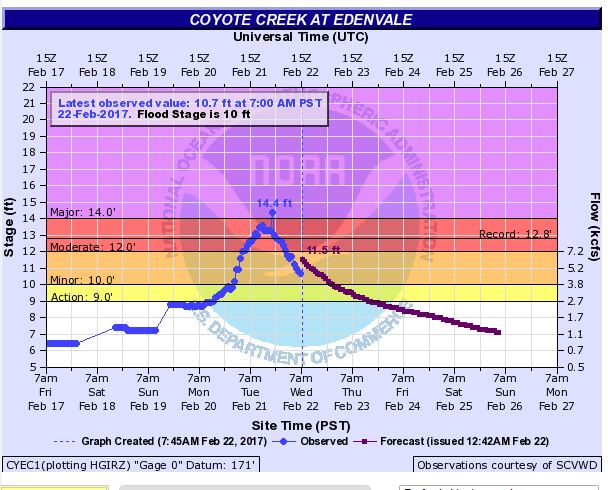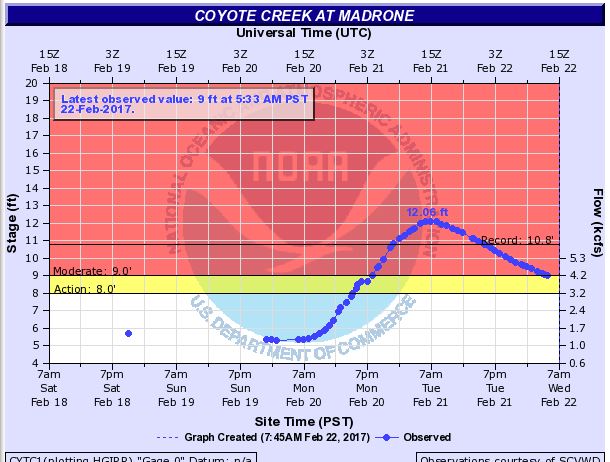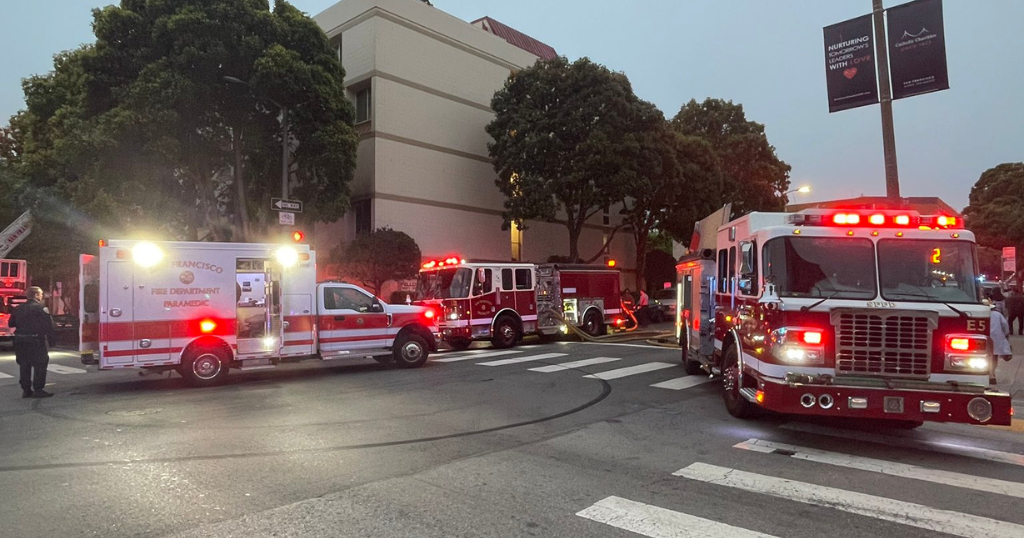Mandatory Evacuations Lifted For Parts Of San Jose As Waters Recede
SAN JOSE (CBS SF) – San Jose city officials announced late Wednesday afternoon that the mandatory evacuation area had been reduced as the Coyote Creek floodwaters continued to recede.
FLOOD VICTIM DONATIONS
San Jose Flood Victims Relief Fund - sjmayor.org
San Jose Earthquakes Relief Fund - Quakes74.gesture.com
Officials started lifting evacuation orders along the seven-mile stretch of Coyote Creek between Highway 237 and I-280 Wednesday afternoon, though some mandatory evacuations are still in effect in other neighborhoods.
At 4 p.m., officials said that the receding flood waters were draining naturally out of some neighborhoods. A new map released by city officials showed that the area still under mandatory evacuation was concentrated on the southern end of the region that was cleared of residents the day before.
Officials said the orange are towards 280 was still not cleared to return, but that the homes in the green area of the map had the mandatory evacuation order lifted for residents to go to home as of Wednesday afternoon.
Officials said some areas were not draining naturally and would still need to be pumped.
In addition to going through areas to see where people would be allowed to go home, the city was continuing to develop on a debris removal plan.
The evacuation centers James Lick High and Evergreen High remained open Wednesday night, but the Mayfair and Shirakawa shelters were set to close.
Officials also wanted to assure residents that drinking water across the city remains safe.
A number of schools will still be closed on Thursday due to the flooding, including San Jose High School, Cristo Rey San Jose Jesuit High School and Rocketship Discovery Prep. Additionally, Empire Gardens, McKinley and Olinder elementary schools will also be closed.
On Wednesday, San Jose flood victim Jonathan Rascon Mata walked to his flooded Rock Springs Avenue apartment wearing home-made trash-bag booties.
He didn't want the filth to ruin his last pair of shoes.
"I wrapped them up in plastic so they don't get contaminated," said Mata. "I would have to throw them away. I can't afford to throw them away right now."
He wore them back into his apartment for the first time since the flood to see how bad the damage was.
The first floor of his home was covered by a thick film of mud. Furniture, electronics and kitchen appliances were all ruined.
"It's a lot you know?" Mata said. "You can't come back to your own house. It's a big loss."
The neighborhood is dotted with flooded cars -- some swamped in mid street as they tried to drive away.
Most of the apartment buildings are spray painted with an "X" on the wall or garage, meaning the city deemed it unsafe to occupy.
"We didn't get any warnings. They kind of just let the water out," said Mata. "At least if we had gotten a warning, we could have gotten our cars out or something."
But not all homes in the flooded area are red-tagged. On Wednesday, neighbors began cleaning up and salvaging what they could.
Lorraine Ortega's Senter Road apartment had just a couple of inches of water inside. She said she'll lose some carpeting, but that's about it.
"It's kind of dry already, a little bit," said Ortega. "I had to stay in a motel last night and I'm just coming home right now. It was scary. This was very scary."
In San Jose's northernmost flood zone, 150 mobile homes were still surrounded by waist-deep water at the South Bay Mobile Home Park along Oakland Road.
Property Manager Genevive Locano said it's been an exhausting two days watching the floodwaters.
"I'm tired. I am," said Locano. "And I know the people are tired and they want to come home. And it's sad. It is."
During an early morning news conference Wednesday, San Jose Mayor Sam Liccardo urged the evacuees not to attempt to return home.
"We are urging people not to return to their homes in those mandatory evacuation areas," he said. "The water is not safe. There is contamination in this water and the contamination runs the gamut."
Liccardo also said there was not timetable for lifting the evacuation orders.
"Bluntly, the water is receding, but we are far from out of this," he said.
Assistant City Manager Dave Sykes said the flooding from the overflow of the Anderson Reservoir "was a 100-year event."
"The situation has now stabilized and we are seeing some improvement, but as the mayor mentioned we are through this," he said.
Sykes said officials were monitoring conditions, but were surprised when floodwaters overwhelmed the Rock Springs neighborhood. They were aware of flooding at 10 a.m. and had rescue crews on the scene at 10:30 a.m.
"It's important to note how swiftly things happened at Rock Springs," he said. "It reached the banks at a flow level much less than capacity. We were not expecting to have conditions at Rock Springs for many, many hours. We certainly were not expecting Rock Springs to be the first place we had issues. So we have to review that issue."
Officials said at least 14,000 residents had evacuated from their homes to escape the rapidly rising waters on Tuesday and another 30,000 lived in neighborhoods put under a voluntary evacuation order late Tuesday night.
Highway 101 reopened in both directions Wednesday morning after being closed overnight due to flooding, according to the California Highway Patrol.
The highway was closed in both directions between Interstate Highway 880 and the Interstate Highway 280 and Interstate Highway 680 interchange at about 10:45 p.m. Tuesday by flooding from the Coyote Creek.
Northbound lanes reopened at about 8:30 a.m. Wednesday, but the southbound lanes remained closed. As of about 10:30 a.m., all lanes had reopened, CHP officials said.
Meanwhile, breakfast was served to those who were displaced after a relatively sleepless night on cots in James Lick High School's gym.
Others awoke at the home of friends and family members or in local hotels and motels.
The plight of the evacuees tugged at the heartstrings of the Bay Area's largest city. Residents like Shelene Huy-Booker were among those dropping off donations of clothing and toys for the children at the evacuation centers.
"I spotted this little girl and all I could she had was this Minnie Mouse (doll)," said Huy-Booker, whose voice was filled with emotions. "She was just looking around like she was lost. This is surreal, so I went home and told my daughter – she's four – I was like: 'We have to do something.' We have to get some toys to take to this little girl."
Evacuees were also telling stories of their rescues from the waters. Flood victim Juanita Wilson said her belongings started to float around her apartment.
"That's like a nightmare, said Wilson. "It's kind of like something you can't believe is happening but it is happening."
Margaret Cervantes lives on the second story of one of the buildings caught in the flood. She lost her car, but was able to grab some valuables.
"Just a little bit overwhelmed with everything that's happened," said Cervantes. "I was fortunate enough to be able to grab baby books, pictures, clothes, my children, so I feel fortunate."
Meanwhile, floodwaters measuring more than four feet deep on some streets had begun to slowly recede.
According to the National Weather Service, the flood waters had receded from a high of 14.4 feet at the height of the surge Tuesday night at Edendale to 11.5 feet by 7 a.m. Wednesday.

At Madrone, the creek has receded from 12.6 feet to 9 feet.

However, the Anderson Reservoir, which drains into the Coyote Creek, remained at more than 100 percent capacity and its spillway was still gushing thousands of gallons of water an hour into the creek.
A flash flood advisory remained in effect at the creek until Saturday.
The water spilling in from Coyote Creek was cold and murky. As it filtered through the neighborhoods, it became a noxious stew of sewage, dirty diapers, household chemicals and engine oil.
At least 225 residents were taken Tuesday to dry land and rinsed with soap and water to prevent them from being sickened by floodwaters. Health officials urged others to get tetanus shots as an extra safety measure.
Santa Clara County Supervisor Cindy Chavez sent out helpful tips for the evacuees when they return home.
- Wear boots and gloves when working in areas which have been flooded.
- Be sure the main electrical switch is off before entering a structure. Do not turn it back on until you are certain there has been no damage to wires or appliances connected to the system.
- Do not use electrical appliances which have been in contact with floodwaters.
- Look carefully for structural damage which could cause injury, i.e., weakened floors, walls or ceilings which might fall or collapse. Watch for exposed nails and other sharp objects.
- Check for wild animals, reptiles and snakes which may have taken up residence to escape the floodwaters. Open all windows and doors to allow them to escape, and avoid trapping or cornering them. Snakes can get inside walls. Be cautious when removing drywall.
- Be especially cautious when approaching sick or injured animals - even household pets.
- Ensure household pets are properly taken care of during recovery operations by providing clean potable water and food to pets. Do not use food that has come into contact with floodwaters.
- Dispose of any small dead animals using gloves and a plastic bag.
- If you smell gas or suspect a gas leak, leave immediately, call 911 and notify the gas company. Warn neighbors of the potential problem.
- Be sure sewer lines are intact before turning on the water or using the toilet.
- Wash hands with soap and water that has been disinfected or boiled. Frequent and thorough handwashing is one of the best and easiest precautions. Don't forget to have children wash, too.



